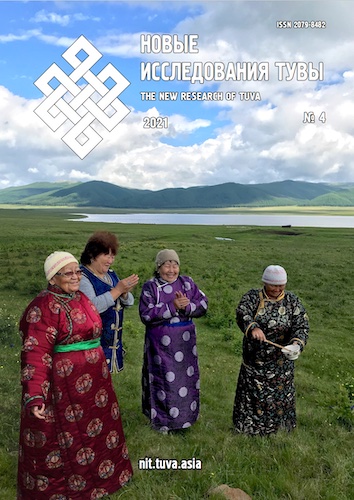Modern labor migration from Kalmykia and Tuva: economic, socio-cultural and gender aspects
DOI:
https://doi.org/10.25178/nit.2021.4.14Keywords:
migration processes; Republic of Kalmykia; Republic of Tuva; internal migration; labor migration; migration intentions; socio-cultural adaptation; labor migrants; gender aspectAbstract
The article presents a comparative analysis of contemporary migration processes in two Russian regions, geographically distant from each other, but having common historical and socio-cultural roots - the Republic of Kalmykia and the Republic of Tuva. They also have similar social and economic performance indicators, and a high level of poverty, all of which tends to push the populations out of both regions. At the same time, the background for labor migration is quite different: while Kalmykia is experiencing depopulation, Tuva’s population is growing.
The authors have analyzed different stages of the migration process in Kalmykia and Tuva, ranging from making a decision to move out of the region, choosing a destination and job search channels, to "adaptability" to the peculiarities of climatic, living and socio-cultural conditions, satisfaction with the level of wages in the new region of residence, as well as further life strategies, such as timing the move or prospects of returning. Special attention was paid to the issues of preserving ethnic and religious identity in a different ethnic environment, to the surviving ties with home area, as well as to the gender aspects of labor migration.
For its sources, the study relies on statistics, and on the in-depth interviews 43 respondents gave in 2021. All of them moved out of their own regions. The respondents from Tuva found the main reason for their migration in the need to pay off credit arrears and to provide for children. For respondents from Kalmykia, migration to the Far North is an opportunity to realize their professional potential and career development, since it is unattainable in their home republic. In-depth interviews confirm that labor migrants maintain close ties with their home area, express a desire to preserve their ethnic and religious identity, and tend to join or start ethnic communities in places of migration.
To conclude, labor migration, despite its recurrent nature, is becoming a prolonged process, and ay in the future become a source of demographic and personnel problems for donor regions, such as Kalmykia and Tuva.
References
Aleshkovskii, I. A. (2007) Determinanty vnutrennei migratsii naseleniia v Rossii [Determinants of internal migration of Russia’s population]: Abstract of Diss. … Candidate of Economy. Moscow. 28 p. (In Russ.).
Anaiban, Z. V. (2020) Sovremennaia migratsionnaia situatsiia v Respublike Tyva [Contemporary migration situation in the Republic of Tuva]. Sciences of Europe, no. 49, pp. 60–62. (In Russ.).
Balakina, G. F. and Anaiban, Z. V. (2016) Osobennosti etnoregional'noi migratsii v Tuve [Features of ethno-regional migration in Tuva]. Sotsiologicheskie issledovaniia, no. 10, pp. 85–92. (In Russ.).
Belousov, S. S. (2006) Osnovnye tendentsii migratsionnykh protsessov naseleniia Kalmykii v postsovetskii period [The main trends of migration of the population of Kalmykia in the Post-Soviet period]. In: Sovremennoe sostoianie i puti razvitiia Iuga Rossii [The current state and ways of developing the South of Russia]. Proceedings of the regional research conference / ed. by G. G. Matishov. Rostov-na-Donu, Iuzhnyi nauchnyi tsentr RAN. 517 p. Pp. 42–44. (In Russ.).
Istoriia Tuvy [The History Of Tuva] (2001) : in 2 vol. 2nd ed / ed. by S. I. Vanshtein and M. Kh. Mannai-ool. Novosibirsk, Nauka. Vol. I. 367 p. (In Russ.).
Kovanova, E. S., Badmaeva, N. V., Udaev, R. A. and Alekseev, S. G. (2019) Etnokul'turnaia bezopasnost' i problemy sokhraneniia iazyka v Kalmykii i Buriatii [Ethnocultural security and problems of language preservation in Kalmykia and Buryatia.]. Oriental Studies, no. 12(6), pp. 1096–1106. (In Russ.). DOI: https://doi.org/10.22162/2619-0990-2019-46-6-1096-1106
Lamazhaa, Ch. K. (2014) Zasaianskie tuvintsy: obraz zhizni, tsennosti, idealy [Trans-Sayan Tuvans: way of living, values and ideals]. New Research of Tuva, no. 3, pp. 152–165. (In Russ.).
Mkrtchian, N. V., Florinskaia, Yu. F. and Kazenin, K. I. (2020) Vnutrenniaia migratsiia kak resurs razvitiia Rossii. Sotsial'no-ekonomicheskie effekty, izderzhki i ogranicheniia [Internal migration as a resource for Russia's development: Socio-economic effects, costs and limitations]. Moscow, RANKhIGS. 76 p. (In Russ.).
Mollerov, H. M. (1989) Istoki bratstva. Russkaia samoupravliaiushchaiasia trudovaia koloniia v Tuvinskoi Narodnoi Respublike [The origins of the brotherhood. Russian self-governing labor colony in the Tuvan People's Republic]. Kyzyl, Tuvan book publisher. 144 p. (In Russ.).
Namrueva, L. V. (2011) Vliianie migratsii molodezhi na sokhranenie etnichnosti (na primere kalmykov) [The impact of youth migration on the preservation of ethnicity: the case of Kalmyks)]. Vestnik Rossiiskogo universiteta druzhby narodov. Seriia: Sotsiologiia, no. 2, pp. 87–92. (In Russ.).
Namrueva, L. V. (2013) Migratsionnye ustanovki molodezhi Kalmykii [Migration attitudes of young people of Kalmykia]. Vestnik Kalmytskogo universiteta, no. 2 (18), pp. 64–70. (In Russ.).
Nikolaeva, A. I. (1967) Trudovye resursy Tuvinskoi ASSR i ikh ispol'zovanie v narodnom khoziaistve [Labor resources of the Tuva ASSR and their use in the national economy]. Uchenye zapiski TNIIIaLI. Issue XII. Kyzyl, Tuvan Book Publishing House. 219 p. Pp. 208–220. (In Russ.).
Rybakovskii, L. L. (2020) Migratsiia naseleniia [Population migration]: a textbook for universities. Moscow, Yurait. 480 p. (In Russ.).
Saryglar, S. A. (2019) Sotsiologicheskii analiz migratsionnoi situatsii v Respublike Tyva [Sociological analysis of the migration situation in the Republic of Tuva]. Sotsial'naia integratsiia i razvitie etnokul'tur v evraziiskom prostranstve, vol. 2, no. 8, pp. 233–238. (In Russ.).
Tinikova, E. E. (2018) Transformatsiia gorodskogo rasseleniia v natsional'nykh respublikakh Iuzhnoi Sibiri v seredine XX — nachale XXI veka [Transformation of urban settlement in the national republics of southern Siberia in the mid-20th to early 21st century]. New Research of Tuva, no. 4, pp. 235–257. (In Russ.). DOI: https://doi.org/10.25178/nit.2018.4.13
Trubin, V., Nikolaeva, N., Miakisheva, S. and Khusainova, A. (2018) Migratsiia naseleniia v Rossii: tendentsii, problemy i puti resheniia [Migration in Russia: trends, problems and solutions]. Moscow, Analiticheskii tsentr pri Pravitel'stve RF. 54 p. (In Russ.).
Ubushaev, M. B. (2009) Migratsionnye protsessy v respublike Kalmykiia v postsovetskii period [Migration processes in the Republic of Kalmykia in the post-Soviet period]. Vestnik Kalmytskogo instituta gumaniatrnykh issledovanii RAN, no. 1, pp. 65–69. (In Russ.).
Kharunova, M. M.-B. and Kharunov, R. Sh. (2021) Osobennosti formirovaniia gorodskogo rasseleniia v Tuve v sovetskii period [Features of urban settlement in Tuva in the Soviet period]. New Research of Tuva, no. 3, pp. 137–147. (In Russ.). DOI: https://www.doi.org/10.25178/nit.2021.3.11
Khol'shina, M. A. (2010) Analiz migratsionnykh protsessov v Respublike Tyva [Analysis of migration processes in the Republic of Tyva]. Aktual'nye voprosy ekonomicheskikh nauk, no. 12–1, pp. 218–222. (In Russ.).
El'diaeva, N. A., Dzhambinova, E. S. and Muchkaev, D. M. (2011) Analiz vnutrennei trudovoi migratsii naseleniia regiona [A study of internal labor migration of the population of the region]. Uchenye zapiski Rossiiskogo gosudarstvennogo sotsial'nogo universiteta, no. 9–2, pp. 115–120. (In Russ.).
El'diaeva, N. A. and Kovanova, E. S. (2018) Vyiavlenie i izmerenie faktorov prodolzhitel'nosti trudovoi migratsii naseleniia (na primere Respubliki Kalmykiia) [Revealing and measuring the factors of the duration of labor migration: the case of the Republic of Kalmykia)]. Voprosy statistiki, vol. 25, no. 7, pp. 40–48. (In Russ.).
Chetyrova, L. B. (2012) Russkoiazychie nerusskikh: istoki i sledstviia [Russian-speaking non-Russians: origins and consequences]. Mundo Eslavo, no. 11, pp. 7–19. (In Russ.).
Published
How to Cite
For citation:
Badmaeva N. V. and Natsak O. D. Sovremennaia trudovaia migratsiia iz Kalmykii i Tuvy: ekonomicheskie, sotsiokul’turnye i gendernye aspekty [Modern labor migration from Kalmykia and Tuva: economic, socio-cultural and gender aspects]. New Research of Tuva, 2021, no. 4, pp. 186-205 (In Russ.). DOI: https://www.doi.org/10.25178/nit.2021.4.14
Issue
Section
Copyright (c) 2021 Журнал "Новые исследования Тувы" (составление)

This work is licensed under a Creative Commons Attribution-NonCommercial 4.0 International License.

Author(s) license holder(s) grant rights for their work to the journal (grantee of a license) under the simple non-exclusive open license in accordance with Art. 1286.1 «Open license for a research work, work of literature or fine arts», Civil Code of the Russian Federation.
New Research of Tuva publishes articles under the Creative Commons Attribution-NonCommercial license (CC BY-NC).
Since it is an open license, author(s) reserve the right to upload the article to their institutional repository, submit it to another journal (if it allows republications), or republish it on their own website (in full, or in part).
However, several conditions apply here:
a) The republished version must always contain the name(s) and affiliation(s) of the author(s), the original title and the hyperlink to the original version on the New Research of Tuva website;
b) It must be in open access, free of charge, and no category of readers must be in any way whatsoever advantaged over general readership.
c) should the contribution be submitted elsewhere by its author(s) without substantial modification (30% or more of original text unchanged), the body of the article should contain a disclaimer that the original version was published in New Research of Tuva (with a link to the respective page)
The CC-BY-NC is a non-revocable license which applies worldwide and lasts for the duration of the work’s copyright.










